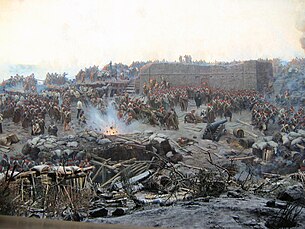Pia Peninsular War: Difference between revisions
Pretzelbomb (talk | contribs) m (Changed "September 1939" to "September 1839") |
No edit summary |
||
| Line 24: | Line 24: | ||
The Pia Peninsular War was one of the first conflicts in which the military used modern technologies such as explosive naval [[wikipedia:Shell (projectile)|shells]], railways, and [[wikipedia:Telegraphy|telegraphs]]. The war was one of the first to be documented extensively in written reports and [[wikipedia:war photography|photographs]]. The war marked a turning point for both Kuresan and Vitosium history. The war weakened both armies, drained the treasury and undermined Kuresa's influence in Eastern [[Adula]]. It would take decades to recover. The humiliation forced Kuresa's educated elites to identify the nation's problems and to recognize the need for fundamental reforms. They saw rapid modernization of the country as the sole way of it recovering the status of a Adulan power. The war was thus a catalyst for reforms of Kuresa's social institutions, including serfdom, justice, local self-government, education, and military service. For Vitosium, the war allowed for increased nationalism and pride due to the successful seizure of territory, although it strained tensions between the east and west of the nation, which eventually culminated in the [[1844 Vitosium Civil War]]. | The Pia Peninsular War was one of the first conflicts in which the military used modern technologies such as explosive naval [[wikipedia:Shell (projectile)|shells]], railways, and [[wikipedia:Telegraphy|telegraphs]]. The war was one of the first to be documented extensively in written reports and [[wikipedia:war photography|photographs]]. The war marked a turning point for both Kuresan and Vitosium history. The war weakened both armies, drained the treasury and undermined Kuresa's influence in Eastern [[Adula]]. It would take decades to recover. The humiliation forced Kuresa's educated elites to identify the nation's problems and to recognize the need for fundamental reforms. They saw rapid modernization of the country as the sole way of it recovering the status of a Adulan power. The war was thus a catalyst for reforms of Kuresa's social institutions, including serfdom, justice, local self-government, education, and military service. For Vitosium, the war allowed for increased nationalism and pride due to the successful seizure of territory, although it strained tensions between the east and west of the nation, which eventually culminated in the [[1844 Vitosium Civil War]]. | ||
==Background== | |||
==War== | |||
===1838=== | |||
===1839=== | |||
==Casualties== | |||
==Belligerents== | |||
{{Template:Coalition of Crown Albatross}} | {{Template:Coalition of Crown Albatross}} | ||
[[Category:Coalition of Crown Albatross]][[Category:Wars]] | [[Category:Coalition of Crown Albatross]][[Category:Wars]][[Category:Vitosium]][[Category:Kuresa]] | ||
Latest revision as of 00:16, 22 December 2020
| Pia Peninsular War | |||||||
|---|---|---|---|---|---|---|---|
 Detail of Kuresa artist Karanz Jourubaud's panoramic painting The Siege of Byamyel (1904) | |||||||
| |||||||
| Belligerents | |||||||
| Vitosium | Kuresa | ||||||
| Commanders and leaders | |||||||
| Ambrose Sanviento | Viktor Borysovych | ||||||
| Strength | |||||||
| Total: 603,132 | Total: 889,000 | ||||||
| Casualties and losses | |||||||
| 223,513 | 210,000 | ||||||
The Pia Peninsular War, also sometimes refered to as the Conquest of Pia or the Great Kuresa War was a military conflict fought from July 1838 to September 1839 in which Kuresa lost the Pia Peninsula region to the Vitosium Empire. The war started in the northern end of the Pia Peninsula in July 1838, when Vitosium troops occupied the Leszłystok Principalities, which were under Kuresan control, then began to cross down the peninsula. For months, Kuresan forces were in effective retreat due to the relentless onslaught of Vitosium armies, though by the winter Kuresa had begun to retake control of the mid-peninsula. The war drew to a stalemate in the winter and spring of 1839, and frustrated by the wasted effort, and with demands for action from their citizens, the Vitosium force decided to attack Kuresa's main naval base in the peninsula region and the Bay of Ontavia at Myrrad. After extended preparations, the forces landed on the peninsula in June 1839 and marched their way to a point south of Myrrad after the successful Battle of the Myrrad Ridge.
The Kuresans counterattacked on 25 August in what became the Battle of Świdwy and were repulsed, but at the cost of seriously depleting the Vitosium Army forces. Myrrad fell after two months. Isolated and facing a bleak prospect of invasion from the West on their mainland if the war continued, Kuresa sued for peace in September 1839. Vitosium welcomed this development, as the conflict was growing unpopular at home. The Treaty of Lipatovce, signed on 30 September 1839, ended the war. It forbade Kuresa from basing warships in the Bay of Ontavia. The Kuresan vassal state of Andaluni became largely independent as well.
The Pia Peninsular War was one of the first conflicts in which the military used modern technologies such as explosive naval shells, railways, and telegraphs. The war was one of the first to be documented extensively in written reports and photographs. The war marked a turning point for both Kuresan and Vitosium history. The war weakened both armies, drained the treasury and undermined Kuresa's influence in Eastern Adula. It would take decades to recover. The humiliation forced Kuresa's educated elites to identify the nation's problems and to recognize the need for fundamental reforms. They saw rapid modernization of the country as the sole way of it recovering the status of a Adulan power. The war was thus a catalyst for reforms of Kuresa's social institutions, including serfdom, justice, local self-government, education, and military service. For Vitosium, the war allowed for increased nationalism and pride due to the successful seizure of territory, although it strained tensions between the east and west of the nation, which eventually culminated in the 1844 Vitosium Civil War.
